Summary:
The risk of Epstein–Barr virus lymphoproliferative disease (EBV-LPD) increases with the use of highly immunosuppressive therapies. Allogeneic BMT, especially supported by T-cell-depleted stem cell products, is a risk factor for EBV-LPD. Although the risk of EBV-LPD after autologous transplantation is low, case reports of this complication in the autologous setting exist. We report a higher incidence than previously described of EBV-LPD in children undergoing sequential high-dose chemotherapy supported with CD34 selected peripheral blood stem cells (CD34+ PBSC). The median time to LPD after tandem transplant was 3 months (range 1–5 months). Five patients out of 156 (3.5%) developed EBV-LPD while enrolled on two trials of tandem autologous SCT in high-risk pediatric malignancies. Both studies employed five cycles of induction therapy, followed by tandem autologous PBSC transplants. In all, 108 out of 156 patients received CD34+ PBSC; 48 received unselected PBSC. All patients contracting LPD were from the CD34 selected group. Treatment of EBV-LPD included rituximab in four out of five patients, IVIg in two out of five patients, and gancyclovir in two out of five patients. EBV-LPD resolved in four out of five patients. We conclude that the combination of tandem SCT and CD34 selection may have increased immunosuppression in these patients to a point where there is an elevated risk of EBV-LPD.
This is a preview of subscription content, access via your institution
Access options
Subscribe to this journal
Receive 12 print issues and online access
$259.00 per year
only $21.58 per issue
Buy this article
- Purchase on Springer Link
- Instant access to full article PDF
Prices may be subject to local taxes which are calculated during checkout

Similar content being viewed by others
References
Leblond V, Sutton L, Dorent R et al. Lymphoproliferative disorders after organ transplantation: a report of 24 cases observed in a single center. J Clin Oncol 1995; 13: 961–968.
Feigel EG . AIDS-associated malignancies: research perspectives. Biochim Biophys Acta 1999; 1423: C1–C9.
Saemundsen AK, Purtilo DT, Sakamoto K et al. Documentation of Epstein–Barr virus infection in immunodeficient patients with life-threatening lymphoproliferative diseases by Epstein–Barr virus complementary RNA/DNA and viral DNA/DNA hybridization. Cancer Res 1981; 41 (Part 1): 4237–4242.
Motohiko O, Gross TG . A review of Epstein–Barr virus infection in patients with immunodeficiency disorders. Am J Med Sci 2000; 319: 392–396.
Saemundsen AK, Berkel AI, Henle W et al. Epstein–Barr virus carrying lymphoma in a patient with ataxia telangiectasia. Br J Haematol 1981; 282: 425–427.
Curtis RE, Travis LB, Rowlings PA et al. Risk of lymphoproliferative disorders after bone marrow transplantation: a multi-institutional study. Blood 1999; 94: 2208–2216.
Shepherd JD, Gascoyne RD, Barnett MJ et al. Polyclonal Epstein–Barr virus-associated lymphoproliferative disorder following autografting for chronic myeloid leukemia. Bone Marrow Transplant 1995; 15: 639–641.
Chao NJ, Berry GJ, Advani R et al. Epstein–Barr virus-associated lymphoproliferative disorder following autologous bone marrow transplantation for non-Hodgkin's lymphoma. Transplantation 1993; 55: 1425–1428.
Hauke RJ, Greiner TC, Smir BN et al. Epstein–Barr virus-associated lymphoproliferative disorder after autologous bone marrow transplantation: report of two cases. Bone Marrow Transplant 1998; 21: 1271–1274.
Yufu Y, Kimura M, Kawano R et al. Epstein–Barr virus-associated T cell lymphoproliferative disorder following autologous blood stem cell transplantation for relapsed Hodgkin's disease. Bone Marrow Transplant 2000; 26: 1339–1341.
Peniket AJ, Perry AR, Williams CD et al. A case of EBV-associated lymphoproliferative disease following high-dose therapy and CD34-purified autologous peripheral blood progenitor cell transplantation. Bone Marrow Transplant 1998; 22: 307–309.
Lones MA, Kirov I, Said JW et al. Post-transplant lymphoproliferative disorder after autologous peripheral stem cell transplantation in a pediatric patient. Bone Marrow Transplant 2000; 25: 1021–1024.
Heath J, Broxson E, Dole M et al. Epstein–Barr virus-associated lymphoma in a child undergoing an autologous stem cell rescue. J Pediatr Hematol Oncol 2002; 24: 160–163.
Stainer CJ, Miflin G, Anderson S et al. A comparison of two different systems for CD34+ selection of autologous or allogeneic PBSC collections. J Hematother 1998; 7: 375–383.
Matthay KK, Villablanca JG, Seeger RC et al. Treatment of high-risk neuroblastoma with intensive chemotherapy, radiotherapy, autologous bone marrow transplantation, and 13-Cis retinoic acid. N Engl J Med 1999; 341: 1165–1173.
Grupp SA, Stern JW, Bunin N et al. Rapid-sequence tandem transplant for children with high-risk neuroblastoma. Med Pediatr Oncol 2000; 35: 696–700.
Grupp SA, Stern JW, Bunin N, Nancarrow C . Tandem high-dose therapy in rapid sequence for children with high-risk neuroblastoma. J Clin Oncol 2000; 18: 2567–2575.
Savoie A, Perpete C, Carpentier L et al. Direct correlation between the load of Epstein–Barr virus-infected lymphocytes in the peripheral blood of pediatric transplant patients and risk of lymphoproliferative disease. Blood 1994; 83: 2715–2722.
Rickinson AB, Moss DJ . Human cytotoxic T lymphocyte responses to Epstein–Barr virus infection. Annu Rev Immunol 1997; 15: 405–431.
Yao QY, Tierney RJ, Croom-Carter D et al. Frequency of multiple Epstein–Barr virus infections from T cell-immunocompromised individuals. J Virol 1996; 70: 4884–4894.
Cohen JI . Epstein–Barr virus infection. N Engl J Med 2000; 343: 481–492.
Rickinson AB, Moss DJ . Human cytotoxic T lymphocyte responses to Epstein–Barr virus infection. Annu Rev Immunol 1997; 15: 405–431.
List AF, Greco A, Vogler LB . Lymphoproliferative diseases in immunocompromised hosts; the role of Epstein–Barr virus. J Clin Oncol 1987; 5: 1673–1689.
Penn I . Cancers complicating organ transplantation. N Engl J Med 1990; 323: 1767–1769.
Martin PJ, Shulman HM, Schubach WH et al. Fatal Epstein–Barr-virus-associated proliferation of donor B cells after treatment of acute graft-versus-host disease with a murine anti-T cell antibody. Ann Intern Med 1984; 101: 310–315.
Chiang KY, Hazlett LJ, Godder KT et al. Epstein–Barr virus-associated B cell lymphoproliferative disorder following mismatched related T cell-depleted bone marrow transplantation. Bone Marrow Transplant 2001; 28: 1117–1123.
Shapiro R, McClain K, Frizzera G et al. Epstein–Barr virus-associated B cell lymphoproliferative disorders following bone marrow transplantation. Blood 1988; 71: 1234.
Briz M, Fores R, Regidor C et al. Epstein–Barr virus associated B cell lymphoma after autologous bone marrow transplantation for T cell acute lymphoblastic leukaemia. Br J Haematol 1997; 98: 485–487.
Young L, Alfieri C, Hennessy K et al. Expression of Epstein–Barr virus transformation-associated genes in tissues of patients with EBV lymphoproliferative disease. N Engl J Med 1989; 321: 1080–1085.
Zutter MM, Martin PJ, Sale GE et al. Epstein–Barr virus lymphoproliferation after bone marrow transplantation. Blood 1988; 72: 520–529.
Faye A, Quartier P, Requerre Y et al. Chimaeric anti-CD20 monoclonal antibody (rituximab) in post-transplant B-lymphoproliferative disorder following stem cell transplantation in children. Br J Haematol 2001; 115: 112–118.
Gross TG, Steinbuch M, DeFor T et al. B cell lymphoproliferative disorders following hematopoietic stem cell transplantation: risk factors, treatment and outcome. Bone Marrow Transplant 1999; 23: 251–258.
Garnier JL, Stevenson G, Blanc-Brunat N et al. Treatment of post-transplant lymphomas with anti-B cell monoclonal antibodies. Recent Results Cancer Res 2002; 159: 113–122.
Philip T, Landstein R, Zucker JM et al. Double megatherapy and autologous bone marrow transplantation for advanced neuroblastoma: the LMCE2 Study. Br J Cancer 1993; 67: 119–127.
Meij P, van Esser JWJ, Niesters HGM et al. Impaired recovery of Epstein–Barr virus (EBV)-specific CD8+ T lymphocytes after partially T-depleted allogeneic stem cell transplantation may identify patients at very high risk of progressive EBV reactivation and lymphoproliferative disease. Blood 2003; 101: 4290–4297.
Mackall CL, Fleisher TA, Brown MR et al. Age, thymopoiesis and CD4+ T lymphocyte regeneration after intensive chemotherapy. N Engl J Med 1995; 332: 143–149.
Mackall CL, Stein D, Fleisher TA et al. Prolonged CD4 depletion after sequential autologous peripheral blood progenitor cell infusions in children and young adults. Blood 2000; 98: 754–762.
Meijer E, Slaper-Coretenbach ICM, Thijsen SFT et al. Increased incidence of EBV-associated LPD after allogeneic stem cell transplantation from matched unrelated donors due to a change of T cell depletion technique. Bone Marrow Transplant 2002; 29: 325–329.
Weinberg K, Blazar BR, Wagner JE et al. Factors affecting thymic function after allogeneic hematopoietic stem cell transplantation. Blood 2001; 97: 1458–1466.
Laport GG, Levine BL, Stadtmauer EA et al. Adoptive transfer of costimulated T cells induces lymphocytosis in patients with relapsed/refractory non-Hodgkin's lymphoma following CD34-selected hematopoietic cell transplantation. Blood 2003; 102: 2004–2013.
Author information
Authors and Affiliations
Corresponding author
Rights and permissions
About this article
Cite this article
Powell, J., Bunin, N., Callahan, C. et al. An unexpectedly high incidence of Epstein–Barr virus lymphoproliferative disease after CD34+ selected autologous peripheral blood stem cell transplant in neuroblastoma. Bone Marrow Transplant 33, 651–657 (2004). https://doi.org/10.1038/sj.bmt.1704402
Received:
Accepted:
Published:
Issue Date:
DOI: https://doi.org/10.1038/sj.bmt.1704402
Keywords
This article is cited by
-
A pilot study of tandem high-dose chemotherapy with stem cell rescue as consolidation for high-risk neuroblastoma: Children’s Oncology Group study ANBL00P1
Bone Marrow Transplantation (2013)
-
Management of HSV, VZV and EBV infections in patients with hematological malignancies and after SCT: guidelines from the Second European Conference on Infections in Leukemia
Bone Marrow Transplantation (2009)
-
Stem cell transplantation for neuroblastoma
Bone Marrow Transplantation (2008)



